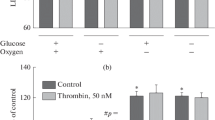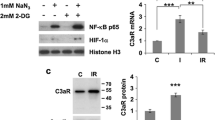Abstract
Protein C anticoagulant system is a multifunctional cofactor-dependent system. In addition to anticoagulant function, activated protein C (APC) also exhibits neuroprotective activity in hypoxia and stroke, but there are no data on potential effects of APC on astrocytes. In the present work we have studied the influence of APC and thrombin on rat astrocytes in primary culture. It was found that thrombin at concentrations above 10 nM (1 U/mL) induced significant activation in the cultured astrocytes resulting in reactive astrogliosis. The cultures exposed to thrombin for 24 h demonstrated a significant increase in proliferation and the S100b protein expression. Thrombin at high concentrations produced visible changes in the cytoskeleton of astrocytes, in particular, an increase in the number of stress fibers in the cultured cells. Moreover, thrombin apparently affected astrocyte migration. Thus, the treatment of serum-starved astrocytes with thrombin resulted in changes in cell monolayer uniformity and formation of “free fields”. APC prevented thrombin-induced proliferation of astrocytes and the S100b protein expression, reducing the parameters under study to the control values. In addition, APC reduced thrombin-induced disorganization of fibrils and formation of “free fields”. The results have demonstrated a new aspect of the protective effect of APC, which suppresses astrocyte activation induced by the proinflammatory effect of thrombin. It suggests a potential application of APC as a regulator of astrogliosis in pathological brain conditions.
Similar content being viewed by others
References
Benarroch E.E. 2005. Neuron-astrocyte interactions: Partnership for normal function and disease in the central nervous system. Mayo Clin. Proc. 80(10), 1326–1338.
Magistretti P.J. 2011. Neuron-glia metabolic coupling and plasticity. Exp. Physiol. 96(4), 407–410.
Bélanger M., Allaman I., Magistretti P.J. 2011. Brain energy metabolism: Focus on astrocyte-neuron metabolic cooperation. Cell Metab. 14(6), 724–738.
Eng L.F., Ghirnikar R.S. 1994. GFAP and astrogliosis. Brain Pathol. 4(3), 229–237.
Mrak R.E., Griffin W.S. 2001. The role of activated astrocytes and of the neurotrophic cytokine S100B in the pathogenesis of Alzheimer’s disease. Neurobiol. Aging. 22, 915–922.
Pindon A., Berry M., Hanta D. 2000. Thrombomodulin as a new marker of lesion-induced astrogliosis: Involvement of thrombin through the G-protein-coupled protease-activated receptor-1. J. Neurosci. 20, 2543–2550.
Wilms H., Sievers J., Rickert U., Rostami-Yazdi M., Mrowietz U., Lucius R. 2010. Dimethylfumarate inhibits microglial and astrocytic inflammation by suppressing the synthesis of nitric oxide, IL-1β, TNF-α and IL-6 in an in-vitro model of brain inflammation. J. Neuroinflamm. 7, 30–37.
Sofroniew M.V. 2009. Molecular dissection of reactive astrogliosis and glial scar formation. Trends Neurosci. 32(12), 638–647.
Nicole O., Goldshmidt A., Hamill C.E., Sorensen S.D., Sastre A., Lyuboslavsky P., Hepler J.R., McKeon R.J., Traynelis S.F. 2005. Activation of protease-activated receptor-1 triggers brain injury. J. Neurosci. 25, 4319–4329.
Striggow F., Riek M., Breder J., Henrich-Noack P., Reymann K.G., Reiser G. 2000. The protease thrombin is an endogenous mediator of hippocampal neuroprotection against ischemia at low concentrations but causes degeneration at high concentrations. Proc. Nat. Acad. Sci. USA. 97, 2264–2269.
Gingrich M.B., Junge C.E., Lyuboslavsky P., Traynelis S.F. 2000. Potentiation of NMDA receptor function by the serine protease thrombin. J. Neurosci. 20(12), 4582–4595.
Nishino A., Suzuki M., Ohtani H., Motohashi O., Umezawa K., Nagura H., Yoshimoto T. 1993. Thrombin may contribute to the pathophysiology of central nervous system injury. J. Neurotrauma. 10, 167–179.
Strukova S.M. 2001. Thrombin as a regulator of inflammation and reparative processes in tissues. Biochemistry (Moscow). 66(1), 8–18.
Niego B., Samson A.L., Petersen K.U., Medcalf R.L. 2011. Thrombin-induced activation of astrocytes in mixed rat hippocampal cultures is inhibited by soluble thrombomodulin. Brain Res. 1381, 38–51.
Ishida Y., Nagai A., Kobayashi S., Kim S.U. 2006. Upregulation of protease-activated receptor-1 in astrocytes in Parkinson disease: Astrocyte-mediated neuroprotection through increased levels of glutathione peroxidase. J. Neuropathol. Exp. Neurol. 65, 66–77.
Ossovskaya V.S., Bunnett N.W. 2004. Protease-activated receptors: contribution to physiology and disease. Physiol. Rev. 84, 579–621.
Wang H., Ubl J.J., Stricker R., Reiser G. 2002. Thrombin (PAR-1)-induced proliferation in astrocytes via MAPK involves multiple signaling pathways. Amer. J. Physiol. Cell Physiol. 283, 1351–1364.
Bhat N.R., Zhang P., Hogan E.L. 1995. Thrombin activates mitogen-activated protein kinase in primary astrocyte cultures. J. Cell Physiol. 165(2), 417–424.
Mosnier L.O., Griffin J.H. 2006. Protein C anticoagulant activity in relation to anti-inflammatory and anti-apoptotic activities. Front. Biosci. 11, 2381–2399.
Zlokovic B.V., Griffin J.H. 2011. Cytoprotective protein C pathways and implications for stroke and neurological disorders. Trends Neurosci. 34(4), 198–209.
Esmon C.T., Glass J.D. 2009. The APCs of neuroprotection. J. Clin. Invest. 119(11), 3205–3207.
Strukova S. 2006. Blood coagulation-dependent inflammation. Coagulation-dependent inflammation and inflammation-dependent thrombosis. Front. Biosci. 11, 59–80.
Strukova S.M. 2004. The role of platelets and serine proteinases in the coupling of blood coagulation and inflammation. Biochemistry (Rus.). 69, 1314–1331.
Zlokovic B.V., Zhang C., Liu D., Fernandez J., Griffin J.H., Chopp M. 2005. Functional recovery after embolic stroke in rodents by activated protein C. Ann. Neurol. 58(3), 474–477.
Gorbacheva L., Davidova O., Sokolova E., Ishiwata S., Pinelis V., Strukova S., Reiser G. 2009. Endothelial protein C receptor is expressed in rat cortical and hippocampal neurons and is necessary for protective effect of activated protein C at glutamate excitotoxicity. J. Neurochem. 111(4), 967–975.
Gorbacheva L.R., Storozhevykh T.P., Pinelis V.G., Davydova O.N., Ishiwata S., Strukova S.M. 2008. Activated protein C via PAR1 receptor regulates survival of neurons under conditions of glutamate excitotoxicity. Biochemistry (Moscow). 73(6), 717–724.
Givens K.T., Kitada S., Chen A.K., Rothschiller J., Lee D.A. 1990. Proliferation of human ocular fibroblasts. An assessment of in vitro colorimetric assays. Invest. Ophthalmol. Vis. Sci. 31(9), 1856–1862.
Hou L., Y., Wang X., Ma H., He J., Zhang Y., Yu C., Guan W., Ma Y. 2011. The effects of amyloid-β42 oligomer on the proliferation and activation of astrocytes in vitro. In Vitro Cell Dev. Biol. Anim. 47(8), 573–580.
Surin A.M., Gorbacheva L.R., Strukova S.M., Pinelis V.G., Storozhevykh T.P. 2009. Fluorescent-microscopic methods for assessment of the functional state and survival potential of neurons. Fluorestsentno-mikroskopicheskie metody otsenki funktsional’nogo sostoyania i vyzhivaemosti neironov. Rukovodstvo k eksperimental’nym rabotam po fiziologii (Guidance on experimental works in physiology). Kamkin A G. and Kiseleva I.S., Eds. Moscow: GeotarMedia, p. 141–187.
Gorbacheva L., Pinelis V., Ishiwata S., Strukova S., Reiser G. 2010. Activated protein C prevents glutamate- and thrombin-induced activation of nuclear factor-κB in cultured hippocampal neurons. Neuroscience. 165(4), 1138–1146.
Tiryaki V.M., Ayres V.M., Khan A.A., Ahmed I., Shreiber D.I., Meiners S. 2012. Nanofibrillar scaffolds induce preferential activation of Rho GTPases in cerebral cortical astrocytes. Int. J. Nanomedicine. 7, 3891–3905.
Suo Z., Wu M., Ameenuddin S., Anderson H.E., Zoloty J.E., Citron B.A., Andrade-Gordon P., Festoff B.W. 2002. Participation of protease-activated receptor-1 in thrombin-induced microglial activation. J. Neurochem. 80, 655–666.
Gorbacheva L.R., Storozhevykh T.P., Pinelis V.G., Ishiwata S., Strukova S.M. 2006. Modulation of hippocampal neuron survival by thrombin and factor Xa. Biochemistry (Moscow). 71(10), 1082–1089.
Wang H., Ubl J.J., Reiser G. 2002. Four subtypes of protease-activated receptors, co-expressed in rat astrocytes, evoke different physiological signaling. Glia. 37(1), 53–63.
Striggow F., Riek-Burchardt M., Kiesel A., Schmidt W., Henrich-Noack P., Breder J., Krug M., Reymann K.G., Reiser G. 2001. Four different types of protease-activated receptors are widely expressed in the brain and are up-regulated in hippocampus by severe ischemia. Eur. J. Neurosci. 14, 595–608.
Schuepbach R.A., Madon J., Ender M., Galli P., Riewald M. 2012. Protease-activated receptor-1 cleaved at R46 mediates cytoprotective effects. J. Thromb. Haemost. 10(8), 1675–1684.
Mosnier L.O., Sinha R.K., Burnier L., Bouwens E.A., Griffin J.H. 2012. Biased agonism of protease-activated receptor 1 by activated protein C caused by noncanonical cleavage at Arg46. Blood. 120(26), 5237–5246.
Author information
Authors and Affiliations
Corresponding author
Additional information
Original Russian Text © A.E. Ivanova, L.R. Gorbacheva, S.M. Strukova, V.G. Pinelis, G. Reiser, 2013, published in Biologicheskie Membrany, 2013, Vol. 30, No. 5–6, pp. 387–397.
Rights and permissions
About this article
Cite this article
Ivanova, A.E., Gorbacheva, L.R., Strukova, S.M. et al. Activated protein C and thrombin participate in the regulation of astrocyte functions. Biochem. Moscow Suppl. Ser. A 8, 50–59 (2014). https://doi.org/10.1134/S1990747813050048
Received:
Published:
Issue Date:
DOI: https://doi.org/10.1134/S1990747813050048




